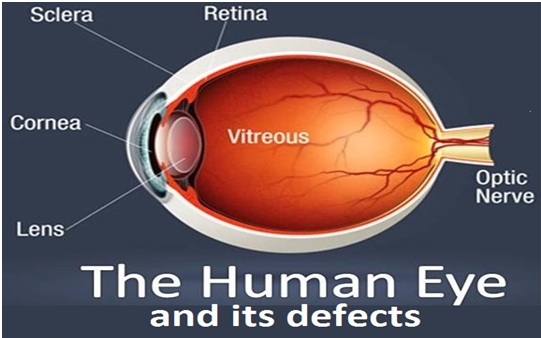
- Detached retina:
- Sometimes the retinal layers become separated but normally there is no space between two retinal layers.
- This separation between retinal layers is called detached retina.
- The blood supply of the neuroretina is impaired and hence becomes non-functional.
- New surgical procedures, including photocoagulation by laser beam and cryosurgery can successfully reattach the retinal layers in about 90% of cases.
- Myopia (Short sightedness):
- A person suffering from this defect cannot see distant objects clearly, but can see clearly, the objects close to the eyes.
- It is mainly a congenital disorder.
- The eye ball is elliptical (elongated) and the visual axis is increased.
- The image is formed in front (before) retina.
- Biconcave (diverging) lens is used for correcting this disorder.
- Hypermetropia (Long sightedness):
- A person suffering from this defect cannot see the near objects distinctly.
- The person has no difficulty in seeing the distant objects.
- It is also a congenital disorder in which the visual axis is shortened.
- Biconvex (converging) lens is used for the correction of this disorder.
- Astigmatism:
- The surface of cornea or lens or both becomes uneven (curved or irregularly shaped) and few parts of the visual field are not in proper focus.
- Cylindrical lens are used for the correctness of this disorder.
- Cataract:
- It may be congenital, traumatic or toxic
- The transparency of the cornea or lens or both, is reduced (lens becomes cloudy or opaque).
- For correction, either the cornea is grafted, or intra-ocular lens (IOL) is surgically implanted.
- Glaucoma:
- It occurs when the aqueous humor doesn’t drain properly and increases the intraocular pressure (above10-20 mmHg).
- Schlemm canal, which drains aqueous humor, is blocked.
- This may cause blindness due to the damage in retina.
- Presbiopia:
- It is an old age defect of the eye.
- It develops due to weakening of ciliary muscles, and the lens cannot thicken properly for viewing nearby objects.
- It is the case of poor accommodation of the eye.
- Biconvex lens is used for its correction.
- Nyctalopia (Night-blindness):
- It develops due to the deficiency of vitamin A (Retinol) in which Rhodopsin pigment is not synthesized in rod cells.
- The affected person is unable to see in dim light.
- Daltonism (Color-blindness):
- It is the most common sex-linked genetic disorder.
- The affected person is unable to distinguish between red and green colors.
- This color blindness is tested by Ishihara chart.
- This defect can be Anopia (all color blindness), Protanopia (red color blindness), Deuteranopia (green color blindness) and Tritanopia (blue color blindness).
- Conjunctivitis:
- It is the inflammation of the conjunctiva.
- It is allergic, bacterial or viral infection of conjunctiva, a covering over the eyeball and the inner side of eye lids.
- It causes discharge, tearing and pain in the eyes.
- Vision, however, generally is not affected.